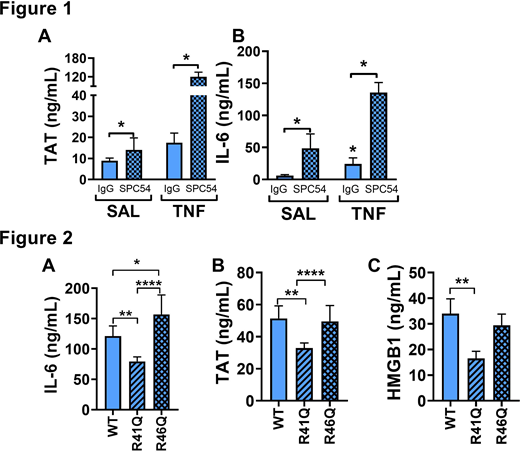Thrombin and activated protein C (APC) are serine proteases involved in coagulation and inflammatory responses. Protease activated receptor-1 (PAR-1) is a G-protein coupled receptor (GPCR) activated by proteolytic cleavage of the extracellular N-terminus. PAR-1 cleavage at R41 by thrombin or at R46 by APC creates unique tethered ligands that activate different signaling pathways. On endothelial cells, thrombin employs PAR-1 to promote endothelial barrier disruption, vascular leakage, and inflammation. In contrast, APC employs PAR-1 to stabilize endothelial barrier and provides anti-inflammatory and anti-apoptotic activities. These opposing effects of PAR-1 activation are a classic example of "GPCR biased signaling". We have previously demonstrated that PAR-1 deficiency in all hematopoietic cells reduces heme-induced vascular stasis in sickle mice. In contrast it does not affect the elevated plasma levels of IL-6 or thrombin-antithrombin (TAT) complexes observed in sickle cell disease (SCD) mice compared to non-SCD controls during steady state.
In this study, we investigated the effects of thrombin- and APC-induced PAR-1 activation on thromboinflammation in the well-characterized Townes mouse model of SCD. Procoagulant and proinflammatory responses were analyzed in control (AA) and sickle (SS) mice at steady state (saline injection) and 5 hours after TNFα (2 µg/kg, i.p.) to mimic the pro-inflammatory milieu that occurs during painful crisis in SCD patients. As previously described, SS mice had elevated plasma levels of TAT compared to AA mice (8.6± 2.4 vs 3.5±0.7ng/mL; p<0.05), that were further enhanced in SS mice by TNFα injection (21.5 ± 4.2 ng/mL, p<0.001). A similar pattern was observed for plasma levels of IL-6 (AA: 2.4±2 vs SS: 18±7.8 ng/mL, p<0.05; SS+TNFα: 231 ± 32 ng/mL, p<0.0001 vs SS).
Using these experimental conditions, we first investigated the role of endogenous APC in SCD. We used a rat anti-mouse protein C mAb (SPC-54), which inhibits the active site of APC, thereby blocking all its enzymatic activities, including PAR-1-dependent signaling and anticoagulant actions. SS mice were injected with anti-APC SPC54 (10 mg/kg) or control IgG antibodies. Eighteen hours later both groups of mice were injected with either saline or TNFα and plasma samples were collected 5 hours later. We TNFαSSdata suggest that endogenous APC has anticoagulant and anti-inflammatory roles for both the steady state and after TNFα challenge.
To address the individual roles of thrombin and APC signaling on vascular inflammation in SCD, we used mice with point mutations in PAR-1 at R41 or R46. Mutation of R41 to Glu (R41Q) renders PAR-1 insensitive to thrombin while preserving APC-mediated cleavage at R46. Mutation of R46 to Glu (R46Q) ablates APC's cytoprotective effects. Bone marrow (BM) from SS mice was transplanted into PAR-1WT, PAR-1R41Q, or PAR-1R46Q mice to generate SSBM mice with either normal PAR-1 (SSBM/PAR-1WT) or the mutated form of this receptor on all non-hematopoietic cells (SSBM/PAR-1R41Q and SSBM/PAR-1R46Q). Four months after BM transplantation, plasma levels of TAT, IL-6, and HMGB1 were analyzed in all 3 groups at steady state or 5 hours after TNFα challenge. Neither the PAR-1R41Q nor PAR-1R46Q mutation on non-hematopoietic cells affected plasma levels of TAT, IL-6, or HMGB1 in SS mice at steady state. Interestingly, plasma levels of IL-6 were significantly elevated in SSBM/PAR-1R46Q mice and reduced in SSBM/PAR-1R41Q mice compared to SSBM/PAR-1WT mice after TNFα challenge, with a statistically significant difference between the two PAR-1 mutant groups. Furthermore plasma levels of TAT and HMGB1 were significantly reduced in SSBM/PAR-1R41Q but not changed in SSBM/PAR-1R46Q mice after TNFα challenge (Figure 2A-C). These data suggest that PAR-1 activation at R41 regulates TAT, IL-6, and HMGB1, whereas activation of R46 negatively regulates IL-6 in sickle mice during TNFα challenge. Our data imply that pharmacological approaches aiming to eliminate thrombin-dependent, while preserving APC-dependent PAR-1 activation, may be effective in attenuating thrombo-inflamatory complications associated with SCD. Studies evaluating the effects of R41Q and R46Q mutations on microvascular stasis in SS mice are currently ongoing.
No relevant conflicts of interest to declare.
Author notes
Asterisk with author names denotes non-ASH members.


This feature is available to Subscribers Only
Sign In or Create an Account Close Modal